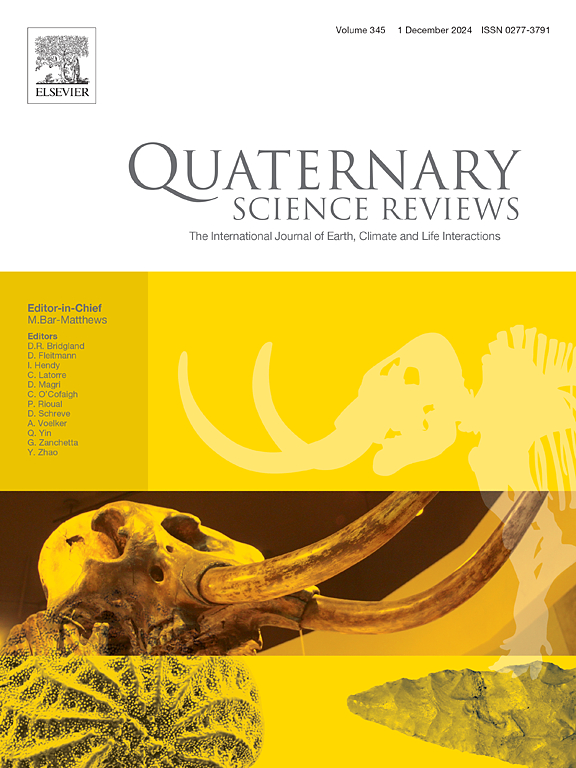The northward expansion of the Tibetan Plateau: Topographic evidence from the Bogda Mts. – southern Junggar Basin coupling system, northwest China
IF 3.2
1区 地球科学
Q1 GEOGRAPHY, PHYSICAL
引用次数: 0
Abstract
The northward propagation of the Tibetan Plateau has led to the orthogonal N–S shortening in northwestern China, which influenced the topographic formation of the E–W trending Bogda Mountains–southern Junggar Basin coupling system. In this study, we focus on the landscape formation of this coupling system and investigate the effect of the propagating deformation in the periphery of the India-Asia collision zone using topographic analysis and optically stimulated luminescence (OSL) dating of river terraces. Together, the results of the topographic analysis show that the normalized steepness index (ksn) value and the scale of knickpoints decrease from west to east, and there is no significant difference in χ values between two sides of the Bogda Mts. Compiled low-temperature thermochronological data for the Bogda Mts. shows a younging trend from west to east, suggesting that the uplift of the western Bogda Mts. began earlier. The OSL dating for the Dalongkou river terraces, on the northern slope of the Bogda Mts. resulted in ages of the T2, T3, T4 river terraces of 6.2 ± 1.3 ka, 13.1 ± 1.7 ka, and 14.2 ± 2.5 ka, respectively. The incision rate of the Dalongkou River increases upstream from about 1.22 mm/yr near to the southern Junggar Basin, to about 2.1 mm/yr, and to approximately 6.33 mm/yr at the base of Bogda Mts. and reveals an upstream increasing uplift rate. Based on these new data, we propose a model of ongoing late Quaternary folding leading to the upbending of central Bogda Mts., with an inflection point of the fold close to the southern Junggar Basin. Combined with the geomorphological comparison with the eastern North Tianshan landscape, we conclude that the lateral intensity of the tectonic uplift from the North Tianshan to Bogda Mts. has gradually weakened, and the uplift of Bogda Mts. has gradually accelerated since the Quaternary and is controlled by N–S orthogonal shortening caused by the India-Asia collision.
青藏高原向北扩张:来自博格达山-南准噶尔盆地耦合系统的地形证据
青藏高原的北移导致西北地区南北正交缩短,影响了东西向的博格达山—南准噶尔盆地耦合系统的地形形成。在这项研究中,我们重点研究了这一耦合系统的景观形成,并利用地形分析和河流阶地的光学激发发光(OSL)测年研究了印度-亚洲碰撞带外围传播变形的影响。地形分析结果表明,波格达达山的归一化陡峭度指数(ksn)值和裂缝点尺度自西向东减小,波格达达山两侧的χ值差异不显著,编制的波格达达山低温热年代学资料呈现自西向东年轻化的趋势,说明波格达达山西部隆升开始较早。波格达山北坡大龙口河阶地的OSL测年结果显示,T2、T3、T4河阶地的年龄分别为6.2±1.3 ka、13.1±1.7 ka和14.2±2.5 ka。在准噶尔盆地南部附近,大龙口河的切割速率从上游的1.22 mm/yr左右增加到2.1 mm/yr左右,在博格达山脚下则增加到6.33 mm/yr左右,显示出上游的隆升速率增加。基于这些新资料,我们提出了一个持续的晚第四纪褶皱模式,导致博格达山中部的上弯,褶皱的拐点靠近准噶尔盆地南部。结合与北天山东部地貌的地貌对比,认为北天山至博格达山的构造抬升横向强度逐渐减弱,第四纪以来博格达山的抬升速度逐渐加快,并受印亚碰撞引起的南北正交缩短控制。
本文章由计算机程序翻译,如有差异,请以英文原文为准。
求助全文
约1分钟内获得全文
求助全文
来源期刊

Quaternary Science Reviews
地学-地球科学综合
CiteScore
7.50
自引率
15.00%
发文量
388
审稿时长
3 months
期刊介绍:
Quaternary Science Reviews caters for all aspects of Quaternary science, and includes, for example, geology, geomorphology, geography, archaeology, soil science, palaeobotany, palaeontology, palaeoclimatology and the full range of applicable dating methods. The dividing line between what constitutes the review paper and one which contains new original data is not easy to establish, so QSR also publishes papers with new data especially if these perform a review function. All the Quaternary sciences are changing rapidly and subject to re-evaluation as the pace of discovery quickens; thus the diverse but comprehensive role of Quaternary Science Reviews keeps readers abreast of the wider issues relating to new developments in the field.
 求助内容:
求助内容: 应助结果提醒方式:
应助结果提醒方式:


